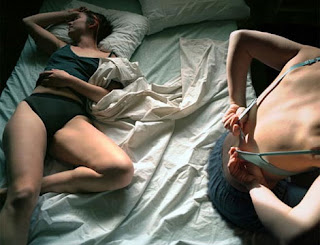Thoughts on criteria for successful art:
-Layers of meaning, so that if one person can't relate to a certain aspect of the work, they can relate to something else in the piece
-Questions should arise when looking at the work, one should feel challenged by the art or one should think about their own experiences in relation to the art
-"When we can't get to the words, maybe that is when the piece works for you" or the indescribable (quote from Roger Ballen at the Photography Lecture Series 9/15)
This isn't everything, but it's some things to consider when creating art. I'm writing this here because of Michael Fried's epigraph,"Each answer remains in force as an answer only as long as it is rooted in questioning," a quote from Heidegger's essay "The Origin of the Work of Art". I don't think art sets out to answer questions, but to propose questions. At least, I think, contemporary art sets out only to raise questions. I think a work of art can be nice to look at, but unless it makes you question something, it cannot stand out as contemporary.
I think and organize my thoughts in lists and bullet points so:
1. Absorption/Theatricality
 |
| Tierney Gearon's The Mother Project |
 |
| Kelli Connell's Double Life |
There are several ways to take a portrait:
1. Where the subject is looking at the camera, therefore looking at the viewer, therefore confronting the viewer
2. A. Where the subject knows they are being photographed, but are actually involved in an activity
B. Where the subject knows they are being photographed, but are performing for the camera
C. Where the subject knows they are being photographed, and are being directed by the photographer
3. Where the subject does not know they are being photographed, thus creating voyeuristic quality, or a "documentary"or exploitive quality because they subject might be showing "real" or "true" emotion, action, etc.
In Cindy Sherman's Untitled Film Stills, Sherman is "performing"in that she is setting everything up for the camera, yet is anti-theatrical because she consciously avoids exaggerated emotion and makes the viewer believe the character she has created is absorbed in whatever is happening in the scene. Adelaide's ideas, take this scenario: you see someone you know on the bus, and you are watching them for a while before you make eye contact and you know they have seen you, but they go back to whatever it is they were doing before. You cannot visibly tell the difference between before their seeing you and after. So, are they performing? Or did they not remember who you were? You cannot know. We cannot tell whether Gearon's image was set up or whether or not the people in the image know they are being photographed. We can assume, because we know how Kelli Connell creates her work, that the image is set up so that the subjects are absorbed in the scene, so they are performing. How does this change our perception of the work?
2. Tableau
 |
| to this (Penelope Umbrico) |
 |
| From this (Margaret Bourk-White for LIFE mag) |
Most art photography was printed at a size that could be easily reproduced (think Cartier-Bresson, Margaret Bourke-White) and when they were hung in galleries, they were matted and framed. Then in the 1970's, the photograph becomes wall sized, Fried uses Jeff Wall's 7 foot-wide transparencies as an example. The size confronts the viewer but draws you into the image, yet the amount of visual detail distances the viewer simultaneously. The way art photography was looked at drastically changed, not only was the content important, but the actual size and scale of the piece mattered as it never had before. When they were matted and framed, they were easily digested, Detail that is important to the work is lost in smaller reproductions, much like in paintings, and the "ephemeral" quality that Walter Benjamin talks about is absolutely important. Photographs become objects in tableau form, one must go to a gallery to see it, not stay at home on the internet or look at it in a magazine.
Content, but also presentation matter. And for some pieces, the presentation is vital, I think many, if not all, works of art photography now consider their presentation as heavily as their content. Would Penelope Umbrico's sunsets be as powerful matted and framed? Of course not, the ideas behind the photographs would be lost.
Content, but also presentation matter. And for some pieces, the presentation is vital, I think many, if not all, works of art photography now consider their presentation as heavily as their content. Would Penelope Umbrico's sunsets be as powerful matted and framed? Of course not, the ideas behind the photographs would be lost.
More on this at a later date.
Contemporary:
Everything at once!
No comments:
Post a Comment